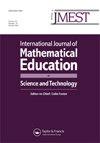调查低年级学生如何推理动态结构中出现的四边形
IF 0.6
Q3 EDUCATION & EDUCATIONAL RESEARCH
International Journal of Mathematical Education in Science and Technology
Pub Date : 2023-09-20
DOI:10.1080/0020739x.2023.2255184
引用次数: 0
摘要
这篇文章的重点是对初中生在使用预先准备好的动态结构时提供的四边形进行推理。在这个主题上,我们提出了一项探索性的实证定性研究,在GeoGebra教室环境中进行,我们的诊断工具由一组基于线和圆组成的四边形的动态结构组成。动态构造由与纸上直尺和指南针相同的构造步骤组成,不需要软件提供任何关系或测量信息。动态结构中的层次结构与对角线的属性有关,具有不同的层次和结构(一个层次,两个连续的层次,两个平行的连续层次对)。对于每一种结构,研究参与者都会推断出在这种结构中可以找到哪些形状以及为什么会出现。数据中出现了不同层次的推理以及学生对四边形不同层次的理解。研究结果表明,至少对于初中生来说,动态操作与几何构造相结合可以为识别四边形的特征和理解它们之间的包容关系提供重要的脚手架空间。本文章由计算机程序翻译,如有差异,请以英文原文为准。
Investigating how lower secondary school students reason about quadrilaterals emerging in dynamic constructions
This contribution focuses on reasoning about quadrilaterals provided by lower secondary school students when working with pre-prepared dynamic constructions. On this topic, we present an exploratory empirical qualitative study carried out within a GeoGebra Classroom environment, and our diagnostic instrument consists of a set of dynamic constructions of quadrilaterals that are based just on a composition of lines and circles. The dynamic constructions consist of the same construction steps as with a straightedge and a compass on paper, without any relational or measurement information provided by the software. The hierarchy in the dynamic constructions is tied to properties of diagonals and takes on various levels and structure (one level, two consecutive levels, two parallel pairs of consecutive levels). For each of the constructions, the participants of the study reasoned which shapes could be found in the construction and why. Various levels of reasoning as well as various levels of students’ understanding of quadrilaterals appeared in data. The findings indicate that, at least for the lower secondary school students, the combination of dynamic manipulations and geometric constructions could form a significant space for scaffolding the identification of the features of quadrilaterals and the comprehension of the inclusive relations between them.
求助全文
通过发布文献求助,成功后即可免费获取论文全文。
去求助
来源期刊

International Journal of Mathematical Education in Science and Technology
EDUCATION & EDUCATIONAL RESEARCH-
CiteScore
3.30
自引率
11.10%
发文量
123
期刊介绍:
Mathematics is pervading every study and technique in our modern world, bringing ever more sharply into focus the responsibilities laid upon those whose task it is to teach it. Most prominent among these is the difficulty of presenting an interdisciplinary approach so that one professional group may benefit from the experience of others. The International Journal of Mathematical Education in Science and Technology provides a medium by which a wide range of experience in mathematical education can be presented, assimilated and eventually adapted to everyday needs in schools, colleges, polytechnics, universities, industry and commerce. Contributions will be welcomed from lecturers, teachers and users of mathematics at all levels on the contents of syllabuses and methods of presentation.
 求助内容:
求助内容: 应助结果提醒方式:
应助结果提醒方式:


